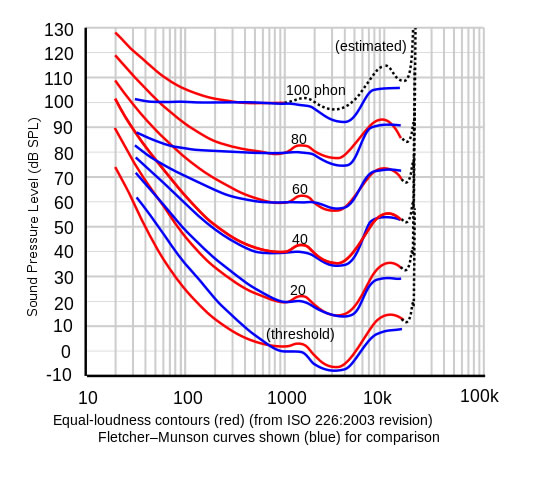- AccurateRip
- Acoustid
- AES/EBU
- AirPlay
- Amplifier
- aptX
- Audio file formats
- ASRC
- AVB
- Bit perfect jitter
- Bits: 16 or 24
- Bit perfect playback
- Bitrate
- Bluetooth
- Burn-in
- BWF
- Cables
- CDtext
- Chromecast
- Clipping
- Clock
- Codec
- Compression
- CRC
- Crossover
- Cue sheet
- DAC
- Damping
- DASH
- Digital
- Digital Room Correction
- Dither
- DLNA
- Drivers
- DoP
- DSP
- EBU R128 (loudness)
- FFT
- FireWire
- Freedb
- Gapless playback
- Generation loss
- HDMI
- Headphone listening
- Hearing
- Hires recording
- Homeplug
- I2S
- ID3
- Inter sample peak
- LDAC
- Linearity (DAC)
- Memory playback
- Music Server
- OCF
- OFC
- PCM
- Perception
- RAID
- ReplayGain
- Ripping
- RFI
- RIAA
- Router
- Sampling, up and over
- Sample Rate Conversion
- Speakers
- S/PDIF
- Storage
- Sync
- Tagging
- Toslink
- Transcoding
- UAA
- Units
- UPnP
- USB
- VST
- WiFi
- WiSA
Hearing
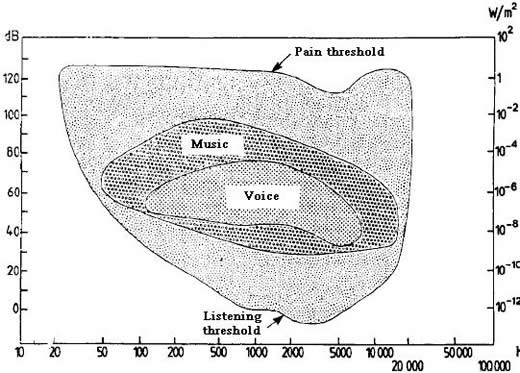
Frequency
When young the range is 20 - 20.000 Hz.
The sensitivity varies with the frequency and is best between 1 kHz and 5 kHz. Your audio components might have a straight frequency response, your ears don't.
You can test the frequency response of your ears here.
Noise Induced Hearing
Noise induced hearing loss is a permanent hearing impairment resulting from prolonged exposure to high levels of noise. Excessive noise exposure is the most common cause of hearing loss.
When noise is too loud, it begins to kill cells in the inner ear. As the exposure time to loud noise increases, more and more hair cells are destroyed. As the number of hair cells decreases, so does your hearing. There is no way to restore life to dead hair cells; the damage is permanent.
Noise can also cause a reversible hearing loss, called a temporary threshold shift. This typically occurs in individuals who are exposed to gunfire or firecrackers, and hear ringing in their ears after the event (tinnitus).
Habitual exposure to noise above 85 dB will cause a gradual hearing loss in a significant number of individuals, and louder noises will accelerate this damage. For unprotected ears, the allowed exposure time decreases by one half for each 5 dB increase in the average noise level. For instance, exposure is limited to 8 hours per day at 90 dB, 4 hours per day at 95 dB, and 2 hours per day at 100 dB. The highest permissible noise exposure for the unprotected ear is 115 dB for 15 minutes per day. Any noise above 140 dB is not permitted.
Source: American Hearing Research Foundation
Presbycusis
A progressive loss of the ability to hear high frequencies, which occurs as people get older.
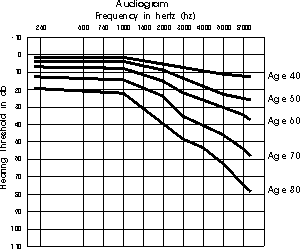
Source: http://www.hearinglosshelp.com/
Some nice empirical evidence.
Dynamic range
Sound is a variation in air pressure. We can detect a change of less than one billionth of standard atmospheric pressure. This is the lower threshold and corresponds to 0 decibels. Sound at 120/130 dB starts to hurt. Our dynamic range is 0 - 130 dB, a difference of 1013 =10.000.000.000.000. That's why a logarithmic scale is used.
Direction
A sound that is of center will reach the ear furthest away later than the closer ear. We can discern approximately 0,002 second time lag.
Pitch
The frequency of a note. Very few people can tell the pitch of an isolated note.
In classical music the A is used to tune. In case of baroque music this is 415, classicism 430 en modern 440 Hz. If you have perfect pitch you have a problem!
Perfect pitch or not, we all can hear a difference of 1 Hz.
Equal loudness contour
Play a reference frequency at a certain level.
Then try other frequencies and adjust the volume until this frequency sounds as loud as the reference. That is what equal loudness is about.
Harvey Fletcher and Wilden A. Munson discovered this phenomenon in 1933.
As a tribute to their fundamental research equal loudness curves are often called Fletcher–Munson curves.
Today equal loudness is an ISO standard (226:2003 revision)
As you can see in the plot, our hearing is non-linear.
If we play a 1000 Hz tone at 0 dB, we need to play a 40 Hz tone at 50 dB to hear it equally loud.
If we play a 1000 Hz tone at 100 dB, we need to play a 40 Hz tone at 115 dB to hear it equally loud.
The frequency response of our hearing is not only non-linear but the non-linearity also varies with the loudness.
Probably our ears are the worst microphones ever.
Test
Hearing test on-line - UNSW
A online hearing test that measures the relative sensitivity of your ears at different frequencies. It produces equal loudness contours or hearing curves – the frequency response of your own ears.
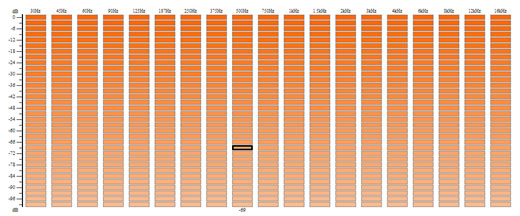
Earful - Audiophile Hearing Test App
Earful is an app designed to measure and evaluate the lower threshold of hearing across a frequency spectrum. It is designed to run on Windows and support ASIO, WASAPI, and Direct Sound audio devices. Use with headphones is recommended for greater accuracy and noise elimination.
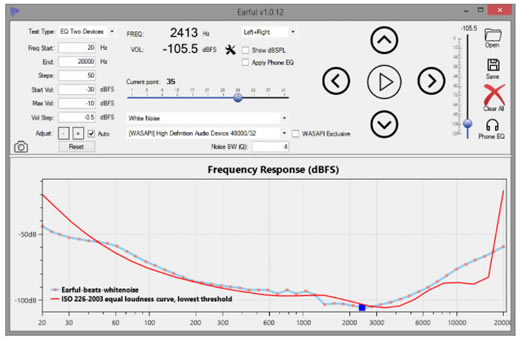
Audio Check
Besides offering all kind of test tones, the blind test section offers all kind of hearing test like:
- Find the smallest difference in sound levels you can detect.
- Find the highest frequency you can reliably hear.
- Find the smallest difference in pitch (frequency) you can hear.
- Find the shortest timing difference you can reliably hear.
- Find the highest dynamic range offered by your listening environment.
- Do you have the absolute hearing ability?
- Are your ears sensitive to Absolute Phase?
- Can you hear a difference between 16-bit and 8-bit audio files?
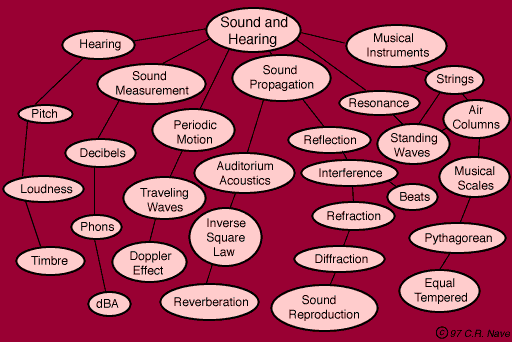
- HyperPhysics - Georgia State University
- Music acoustics - Joe Wolfe, University of New South Wales, Australia
- Fundamentals of Hearing - JJ Johnston
- A Brief History of Tuning - The Schiller Institute i
- Simple Hearing Test, Anyone else want to try? - Hydrogenaudio
- Hearing test on-line: sensitivity, equal loudness contours and audiometry - Joe Wolfe, University of New South Wales, Australia
- Noise Induced Hearing Loss - American Hearing Research Foundation
- Audio Check


